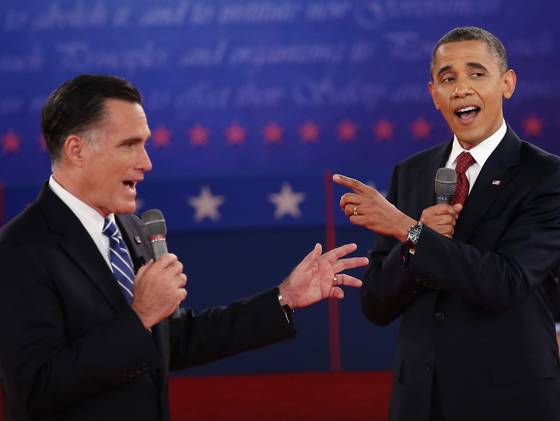Red state is Republican, Blue state Democrat
 |
| Blue-tied Romney sparring with red-tied Obama (photo from USA Today) |
A state is considered blue if the voting history trends to the
Democratic party and red if it trends towards the Republican party. These
colors are selected because they are on the opposite ends of the color
spectrum. In other countries, the color scheme is rversed, where red is the
color of the liberals and blue the conservatives. The exact use of this color
scheme emerged in the 2000 elections, due more to general agreement among
commentators than anything else.—Charlie
Red=Republican. Blue=Democrat.
There isn't any deep meaning. [my emphasis] It just
happened that way in the media broadcast of the 2000 presidential race. After
that, it became the accepted, albeit unofficial nomenclature of politics. As
Wikipedia describes it:
"Early on, the most common—though again, not
universal—color scheme was to use red for Democrats and blue for Republicans.
This was the color scheme employed by NBC—David
Brinkley famously referred to the 1984 map showing Reagan's
49-state landslide as a "sea of blue", but this color scheme was also
employed by most newsmagazines. CBS during this same period, however, used the
opposite scheme—blue for Democrats, red for Republicans. ...
"But in 2000, for the first time, all major electronic media
outlets used the same colors for each party: Red for Republicans, blue for
Democrats. Partly as a result of this near-universal color-coding, the terms Red
States and Blue States entered
popular usage in the weeks following the 2000 presidential election.
Additionally, the closeness of the disputed election kept the colored maps in
the public view for longer than usual, and red and blue thus became fixed in
the media and in many people's minds. [2] Journalists began to routinely
refer to "blue states" and "red states" even before the
2000 election was settled. After the results were final, journalists stuck with
the color scheme . . . . Thus red and blue became
fixed in the media and in many people's minds [3] despite the fact that no
"official" color choices had been made by the parties.
The quote goes on and on…
What I find interesting is the assertion that “there is no deep meaning” in it. But of course there is. Since the ‘Teens of the 20th century, the Red Party has been associated with the Communist Party. To be called a “Red” was the same as being called a Communist. And Communists, as we all know, are associated with the Left. And Democrats, though becoming more and more Centrist, began on the Left even if they’ve moved to the Middle.
So what’s going on here? It’s taken me years to adjust (and I still haven’t or hadn’t adjusted) to thinking of the Red Party as the Republican Party. Interestingly, this color code-switching nearly coincides with the demise and eventual collapse of the Soviet Union, one of the last bastions of so-called “Communism.”
Is there a deliberate emptying out of signified tied to the signifier of color?
With last night’s reversal: the Democrat sporting a bright red to go with the bright red carpet, the Republican sporting a royal blue tie to match the sky blue walls, I’m perplexed. Perhaps it was Obama unconsciously signaling to his constituents that he was still on the Left. And Romney signaling he was still the party of the rich. Their people must decide these things beforehand. Imagine if both came out wearing the same color tie. . .
The only thing constant was the two wives of the two candidates as well as the first woman commentator on PBS in luscious hot pink: pink being the color the most closely identified with women and femininity and sex. According to the InternetSlang dictionary, PINK means "Vagina."http://www.internetslang.com/PINK-meaning-definition.asp
No comments:
Post a Comment